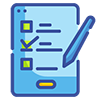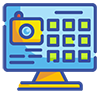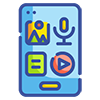Create a Content Plan

How to Create a Content Plan that Brings Results
Do you create content for social media? Run an e-commerce website? Or own a personal blog?
To reach your target audience and generate buzz, you need a solid content plan. This includes setting goals, knowing your audience, and choosing the right channel to market your content.
Don’t worry. It’s not as complicated as it might sound. Follow the simple steps below to create a content plan that brings outstanding results.
Steps to Create a Content Plan
You can create a content plan in just 9 steps. Start by defining your goals, knowing your audience, and assessing your current content.
Next, decide on the type of content you need to create. You can then brainstorm content ideas and market them well.
Follow our detailed step-by-step guide to create a content plan that brings results.
1. Define Your Goals
 There’s no point in creating aimless content. So, the first step is to define your content goals, both for the short and long term. This will help you focus on what’s important and what’s not.
There’s no point in creating aimless content. So, the first step is to define your content goals, both for the short and long term. This will help you focus on what’s important and what’s not.
To simplify your goals, make sure it’s SMART: specific, measurable, attainable, realistic, and time-based.
2. Know Your Audience
 If you want to connect with your audience, know them better. This is especially important if you’re new to marketing. So, how to know your target audience? In a few easy steps:
If you want to connect with your audience, know them better. This is especially important if you’re new to marketing. So, how to know your target audience? In a few easy steps:
- Collect demographic data: Know the age, gender, education, and income of your audience via Google Analytics.
- Get customer feedback: Feedback can help you learn more about your target audience, such as their likes and dislikes, needs, and problems.
- Create buyer personas: Once you have the demographic data and feedback, you can create buyer personas (or avatars). These will help you know your audience and better target your content.
3. Assess Your Current Content
 If you already have content out there, time to assess it. This includes website blogs, social media posts, podcasts, and videos. See which type of content performs better than others.
If you already have content out there, time to assess it. This includes website blogs, social media posts, podcasts, and videos. See which type of content performs better than others.
Ask yourself: are the keywords relevant? Do you need more inbound links? Is the content easy to understand? Once you have the answers, use the information to decide which direction you take next.
4. Decide on Content Types
 Now, see which type of content you must create. There are plenty of options out there, from written content like blog posts to audio content like podcasts and visual content like videos.
Now, see which type of content you must create. There are plenty of options out there, from written content like blog posts to audio content like podcasts and visual content like videos.
You don’t have to pick just one type of content. You can create a mix of blogs, podcasts, and videos for the best results.
5. Brainstorm Content Ideas
 Now it’s time to come up with ideas for your next project. List down the type of content and topics that speak to your audience. Based on these, brainstorm content ideas with your team.
Now it’s time to come up with ideas for your next project. List down the type of content and topics that speak to your audience. Based on these, brainstorm content ideas with your team.
You can also use the internet to track trendy topics and popular content.
6. Choose Content Channel
 At this step, see where your audience is hanging out. This will help you pick the right content channel. For instance, should you post on social media, blog about it, or focus on your website?
At this step, see where your audience is hanging out. This will help you pick the right content channel. For instance, should you post on social media, blog about it, or focus on your website?
Your target audience is most likely using one or two of these channels. With the right information, you can easily deliver your content to them.
7. Create a Content Calendar
 For a superb content plan, a content calendar is a must-have. It will help you know exactly when to publish your content on different platforms.
For a superb content plan, a content calendar is a must-have. It will help you know exactly when to publish your content on different platforms.
Punch all the important details like the date, content type, goal, allocated budget, and status of the work into your calendar. This will work wonders for you, especially if you’re publishing a lot of content.
8. Create and Market Your Content
 Create meaningful content that reflects your brand’s personality and values. Keep in mind SEO while building your content.
Create meaningful content that reflects your brand’s personality and values. Keep in mind SEO while building your content.
The next key part is to market the content well. You can, of course, use your blog, social media platforms, and website. But you can also send out emails, connect with influencers, and opt for paid ads.
9. Measure and Analyze
 Once your content is out there, you can assess its performance. Use Google Analytics for information on how your audience is interacting with your content.
Once your content is out there, you can assess its performance. Use Google Analytics for information on how your audience is interacting with your content.
Use this info to fine-tune your content so that it can be more effective.
Create a Content Plan – The Takeaway
Creating a content plan is an important part of reaching your target audience and engaging them. But that’s not all.
A content plan will help you set realistic goals and achieve them, too. Plus, you can monitor your progress and tweak your content for your audience, so it’s always up to date.